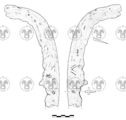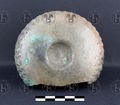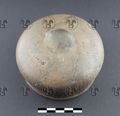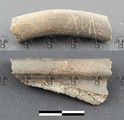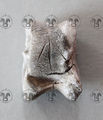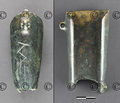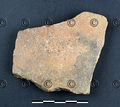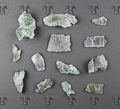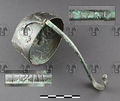Non-script notational systems
Preliminaries
The Raetic corpus at it presents itself today contains a considerable number of "inscriptions", that can – with varying degrees of certainty – be determined not to represent "proper" script in the linguistical sense (i.e., reflecting linguistic units). The vast majority of these, however, must be expected to have a para-linguistic meaning, and should not be completely disregarded. This page collects the correspondent material from the corpus, new inscriptions from LIR which have not been included in the TIR, as well as diverse testimonies mentioned in the literature, which have been examined at various repositories by the TIR project staff. To facilitate reference, we have attempted a preliminary organisation of the material by assigning all these testimonies the sigla code EX ("excluded"), regardless of their provenance. An introduction presenting options for classification and interpretation of the material will follow in time.
Potentially relevant testimonies included in the Raetic corpus (autopsied)
- potential factory marks on rims and handles of metal vessels: BZ-7.1, BZ-7.2, BZ-8.1, BZ-8.2, NO-8, SZ-18, SZ-35, SZ-36, SZ-37.1, SZ-37.2, SZ-75, SZ-82
- potential factory marks on iron implements:
- (including) symbols / ornament (?): BZ-19, SZ-25, SZ-26 (?), SZ-78, SZ-80
- on scythe rings and related: SZ-44.1, SZ-44.2, SZ-45.1, SZ-45.2, SZ-46.1, SZ-46.2; SZ-47, SZ-72 (different groups); SZ-50, SZ-51 (tools)
- on the side of axe heads: SZ-62, SZ-76.1, SZ-76.2, SZ-77, SZ-81
- letter: SZ-33, SZ-74 (þine), SZ-43.1, SZ-43.2, SZ-79.1, SZ-79.2 (uli)
- on bronze implements: HU-1; SZ-65.1, SZ-65.2 (ku)
- on statuettes: SZ-20, SZ-71
- on bone/antler: BZ-15, SZ-48, SZ-49, SZ-63
- on pottery: BZ-20, BZ-21, BZ-22, BZ-23, IT-9, IT-10, SZ-55, SZ-69, SZ-83, WE-8.1, WE-8.2; NO-14, WE-7 (θr)
- on stone: IT-6
Additional material from Raetic context (geographical/archaeological) – preliminary collection
| Provenance | Description | Literature | Images | Dating |
|---|---|---|---|---|
| Himmelreich | Numerous fragments of pottery bearing diverse characters, often on handles and bottoms, ranging from obviously non-script, ornament-like scratchings and symbols to such as might be interpreted as letters (e.g. |
Sinnhuber 1949, Kasseroler 1957 | Drawings in Kasseroler 1957, with a table of signs (pl. 63); photos in Sinnhuber 1949 (pl. XXV) | La Tène period according to the archaeological context |
| Ganglegg |
Besides the inscribed bones and bone points discovered on the Ganglegg hill which are included in the TIR, a large number of objects of the same kind were found (bones: EX-20 to 23, EX-30 (astragalos); bone points: EX-16 to 19, EX-23 to 27). These bear (supposedly) non-script characters the interpretation of which is uncertain. Some of the characters are formally identical with letters (e.g. |
Gamper 2006: 142-146 | Drawings in Gamper 2006: fig. 76 and 77 | 3rd-1st centuries BC (by archaeological context) |
| Marks on helmets |
|
Lunz & Morandi 2003: 343 f. | 5th–1st c. BC (typology) | |
| Sanzeno I (symbols on iron) |
Many heavy iron implements from Sanzeno (apparently a centre of iron workmanship), namely chisels, gouges, ferrules, axe heads, hoes, sickles, scythe rings and knives, bear marks, often in the same spot on the same type of object. The most regularly recurring characters are the asterisk |
LIR; some already in Nothdurfter 1979 | LIR; some already in Nothdurfter 1979 | |
| Bostel |
|
MLR 103, 105, 119 | Photos in MLR | |
| Marks on fibulas | The Raetic corpus contains one potential inscription on a fibula (NO-9), which is highly suspect of being ornamental. Parallels: fibulas from Pfaffenhofen (Landeskonservatorat für Tirol), EX-46 | |||
| Marks on bronze axes from the Hallstatt era | A substantial collection of bronze axe heads bearing diverse marks are preserved in the Archäologisches Museum Fliess (EX-82); four more pieces are kept in the Castello del Buonconsiglio (EX-32, EX-33, EX-34, EX-83; a fifth axe with Inv.No. 2.790 is missing). They are too old to be considered in any way connected to the Raetic script proper, but may be of relevance for the interpretation of non-script marks contemporaneous with it. BZ-17 belongs with this group. | Hallstatt era | ||
| Marks on Astragaloi | EX-30, EX-51. The only known inscription on an astragalos (which also bears additional marks) is NO-13. |
Dubious cases which ought to be mentioned
- EX-80: A wooden board, unpublished, currently at the Amt für Bodendenkmäler Bozen / Ufficio Beni archeologici Bolzano. Along one lengthwise edge, discolourations and to some extent indentations in the shape of lines, which might possibly be traces of characters. The lines cannot be arranged into letters; they are more likely to be marks left by some kind of metal fitting or the like.
- New inscriptions in LIR which have not been included in the TIR:
- EX-1 (SA-96) – clearly ornamental (see drawing on this page)
- EX-7 (SA-83) – fragmented, but more likely to be a zig-zag ornament
- EX-8 (SA-94) – a
 -shape on a handle, isolated and in the context of ornament
-shape on a handle, isolated and in the context of ornament - EX-11 (SA-107) – the symbols
 and
and  on a bronze handle; see above "Sanzeno I"
on a bronze handle; see above "Sanzeno I" - EX-14 (NO-2) – illegible; maybe comparable with the group "Sanzeno I" above
Images
|
| ||||
Bibliography
| Bassi 1996 | Cristina Bassi, "Catalogo e osservazioni di carattere tipo-cronologico", in: Umberto Raffaelli (Ed.), Oltre la porta. Serrature, chiavi e forzieri dalla preistoria all'età moderna nelle Alpi orientali. Catalogo della mostra tenuta a Trento, Castello del Buonconsiglio, dal 13 luglio al 31 ottobre 1996, Trento: Castello del Buonconsiglio. Monumenti e collezioni provinciali 1996, 84–93. |
|---|---|
| De Guio 2011 | Armando De Guio (Ed.), "Bostel di Rotzo (VI) - stato di avanzamento delle ricerche", Quaderni di Archeologia del Veneto (QdAV) XXVII (2011), 168–183. |
| Egg 1986 | Markus Egg, Italische Helme. Studien zu den ältereisenzeitlichen Helmen Italiens und der Alpen. Teil 1: Text, Teil 2: Tafeln, Mainz: Römisch-Germanisches Zentralmuseum 1986. |
| Fogolari 1960 | Giulia Fogolari, "Sanzeno nell'Anaunia", in: Deputazione di Storia Patria per le Province di Romagna (Eds), Civiltà del Ferro. Studi pubblicati nella ricorrenza centenaria della scoperta di Villanova [= Documenti e studi VI], Bologna: Forni 1960, 265–321. |
| Gamper 2000 | Peter Gamper, "Die latènezeitlichen Befunde und Funde", Der Schlern 74 (2000), 633–663. |
| Gamper 2006 | Peter Gamper, Die latènezeitliche Besiedlung am Ganglegg in Südtirol. Neue Forschungen zur Fritzens-Sanzeno-Kultur [= Internationale Archäologie 91], Rahden/Westfalen: Leidorf 2006. |
| Gamper & Steiner 1999 | Peter Gamper, Hubert Steiner, Das Ganglegg bei Schluderns. Eine befestigte bronze- und eisenzeitliche Siedlung im oberen Vinschgau, Bozen: Athesia 1999. |
| Ghislanzoni 1930–31 | Ettore Ghislanzoni, "La stipe votiva di S. Maurizio presso Bolzano", Bullettino di paletnologia italiana (BPI) L–LI (1930–1931), 179–188. |
| Ghislanzoni 1931 | Ettore Ghislanzoni, "Sanzeno nell'Anaunia. Scavi di abitazioni preromane", Notizie degli Scavi di Antichità , Vol. VII (1931), 409–471. |
| Gleirscher et al. 2002 | Paul Gleirscher, Hans Nothdurfter, Eckehart Schubert, Das Rungger Egg. Untersuchungen an einem eisenzeitlichen Brandopferplatz bei Seis am Schlern in Südtirol [= Römisch-Germanische Forschungen Band 61], Mainz: Philipp von Zabern 2002. |
| Kasseroler 1957 | Alfons Kasseroler, Die vorgeschichtliche Niederlassung auf dem „Himmelreich“ bei Wattens [= Schlern-Schriften 166], Innsbruck: Wagner 1957. |
| Kluge 2017 | Sindy Kluge, "Rätische UnSchriften. Überlegungen zu zwei Fallbeispielen", in: Raimund Karl, Jutta Leskovar (eds), Interpretierte Eisenzeiten. Fallstudien, Methoden, Theorie. Tagungsbeiträge der 7. Linzer Gespräche zur interpretativen Eisenzeitarchäologie, Linz: 2017, 311–322. |
| Kluge & Salomon 2015 | Sindy Kluge, Corinna Salomon, "Ausgewählte Funde aus Dercolo im Kontext der rätischen Inschriften", Wissenschaftliches Jahrbuch der Tiroler Landesmuseen 8 (2015), 80–95. |
| LIR | Alberto Mancini, Le Iscrizioni Retiche [= Quaderni del dipartimento di linguistica, Università degli studi di Firenze Studi 8–9], Padova: Unipress 2009–10. (2 volumes) |
| Lunz 1974 | Reimo Lunz, Studien zur End-Bronzezeit und älteren Eisenzeit im Südalpenraum, Firenze: Sansoni 1974. |
| Lunz & Morandi 2003 | Reimo Lunz, Alessandro Morandi, "Un frammento di elmo di bronzo con iscrizione retica da Settequerce – Siebeneich", Archeologia Classica LIV (2003), 341–349. |
| Marinetti 2003 | Anna Marinetti, "Iscrizioni retiche di San Giorgio Valpolicella (VR)", Quaderni di Archeologia del Veneto (QdAV) IXX (2003), 111–117. |
| Marinetti 2004 | Anna Marinetti, "Nuove iscrizioni retiche dall'area veronese", Studi Etruschi 70 (2004), 408–420. |
| Marinetti 2011b | Anna Marinetti, "Le iscrizioni retiche dal Bostel di Rotzo (Vicenza)", Quaderni di Archeologia del Veneto (QdAV) XXVII (2011), 201–203. |
| Marzatico 1997 | Franco Marzatico, I materiali preromani della Valle dell’Adige nel Castello del Buonconsiglio [= Patrimonio storico artistico del Trentino 21], Trento: 1997. (3 volumes) |


